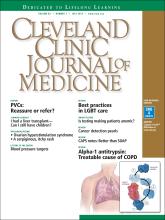Article Figures & Data
Tables
Consider questions inclusive of nonbinary identities—instead of asking whether the patient identifies as a man or a woman or as gay or straight, ask about anatomy and behavior, eg: Are you sexually active? (Explore what sexual activity means for the patient)
With whom do you have sex? Men, women, or both?
What parts of your body do you use when having sex with your partner(s)?
Do you practice safer sex? (Explore what safer sex means for the patient)
With primary partners?
With casual partners?
How do your partners identify their gender or sexual orientation?
Sex—refers to the physical genotype and phenotype, without regard to the sense of self Cisgender—relating to a person whose gender identity and biological sex correspond Gender identity—inherent sense of being male or female regardless of genotypic, phenotypic, or biochemical sex; also referred to as affirmed gender Genderqueer—one who defies or does not accept stereotypical gender roles and may choose to live out-side expected gender norms. Genderqueer people may or may not avail themselves of hormonal or surgical treatments. Sexual orientation—how a person identifies their physical and emotional attraction to others Transgender—an umbrella term used to describe the discordance between a person’s gender identity and expression and the cultural expectations based on the sex assigned at birth Transsexual—an older term that originated in the medical and psychological communities and is typically ascribed to adults committed to making their bodies congruent with their gender identity. This term is still preferred by some people who have permanently changed or seek to change their body through medical interventions (including but not limited to hormone therapy and surgery). Adapted from references 10, 11, 29, and 32
What to do Why Establish gender-neutral bath-rooms and avoid restroom signage that specifically designates one gender or another Transgender individuals should feel comfortable using a rest-room that corresponds to their gender identity and expression Avoid clinic names and signs that seem welcoming to only one gender (eg, Men’s Health Center, Women’s Health Center) Gender-specific clinic names or centers may not appeal to or affirm gender-nonconforming people Create initial patient intake forms that collect information on the patient’s preferred name, pronoun, gender identity, sex as- signed at birth, partner, and other family members This information will help providers and staff address the patient correctly, both by name and pronoun Create electronic health record forms that allow for collection of gender identity and natal sex that also include an anatomic inventory This information will help providers address individuals’ specific healthcare needs according to their natal sex and current anatomy Screening service or immunization Men who have sex with men Women who have sex with women Transgender men a Transgender women a Annual screening for gonorrhea, Chlamydia, syphilis
(every 6 months if high risk)Yes Chlamydia screening for all women age < 25
Consider based on exposure and riskConsider based on exposure and risk Consider based on exposure and risk Annual screening for HIV
(every 6 months if high risk)Yes Consider based on exposure and risk Consider based on exposure and risk Consider based on exposure and risk Offer HPV vaccination
(up to age 26)Yes Yes Yes Yes Give meningococcal vaccine (if additional risk factor is present) Yes Consider based on exposure and risk Consider based on exposure and risk Consider based on exposure and risk Assess for immunity to hepatitis A and B,
immunize if not immuneYes Consider based on exposure and risk Consider based on exposure and risk Consider based on exposure and risk Screen for anxiety, depression, and other mental health disorders Yes Yes Yes Yes Assess for substance use disorders
(tobacco, alcohol, drug use)Yes Yes Yes Yes Assess risk factors for breast cancer, offer mammography Not applicable Yes Perform chest wall examination after chest surgery; other- wise mammography as recommended for cisgender women Consider if previously or currently treated with hormone therapy and having additional risk factors (family his- tory, obesity, estrogen and progestin use greater than 5 years) Screen for cervical cancer at appropriate intervals
(if no hysterectomy)Not applicable Yes Yes Not applicable Assess risk factors for osteoporosis Not applicable Bone density testing starting at age 65 or earlier based on risk factors Bone density at age 60 or earlier based on risk factors
Consider in those not compliant with hormone therapyBone density at age 60 or earlier based on risk factors
Consider in those not compliant with hormone therapy↵a Transgender men are people with the XX genotype who identify as male; transgender women are people with the XY genotype who identify as female.






